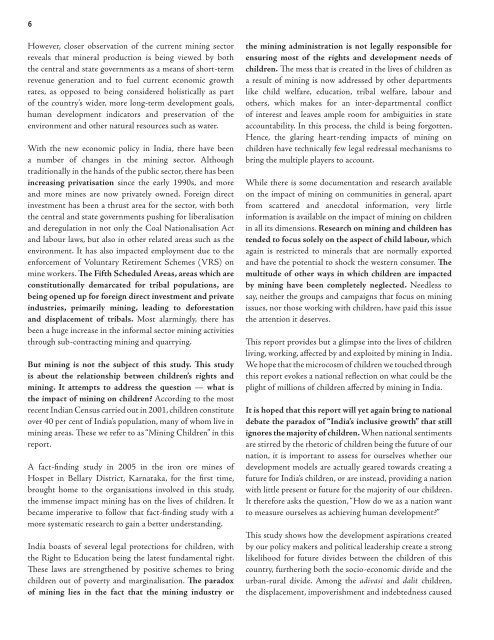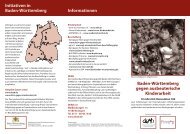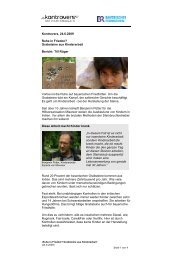Children - Terre des Hommes
Children - Terre des Hommes
Children - Terre des Hommes
You also want an ePaper? Increase the reach of your titles
YUMPU automatically turns print PDFs into web optimized ePapers that Google loves.
6However, closer observation of the current mining sectorreveals that mineral production is being viewed by boththe central and state governments as a means of short-termrevenue generation and to fuel current economic growthrates, as opposed to being considered holistically as partof the country’s wider, more long-term development goals,human development indicators and preservation of theenvironment and other natural resources such as water.With the new economic policy in India, there have beena number of changes in the mining sector. Althoughtraditionally in the hands of the public sector, there has beenincreasing privatisation and more mines are now privately owned. Foreign directinvestment has been a thrust area for the sector, with boththe central and state governments pushing for liberalisationand deregulation in not only the Coal Nationalisation Actand labour laws, but also in other related areas such as theenvironment. It has also impacted employment due to theenforcement of Voluntary Retirement Schemes (VRS) onmine workers. The Fifth Scheduled Areas, areas which areconstitutionally demarcated for tribal populations, arebeing opened up for foreign direct investment and privateindustries, primarily mining, leading to deforestationand displacement of tribals. Most alarmingly, there hasbeen a huge increase in the informal sector mining activitiesthrough sub-contracting mining and quarrying.But mining is not the subject of this study. This studyis about the relationship between children’s rights andmining. It attempts to address the question — what isthe impact of mining on children? According to the mostrecent Indian Census carried out in 2001, children constitutemining areas. These we refer to as “Mining <strong>Children</strong>” in thisreport.A fact-finding study in 2005 in the iron ore mines ofHospet in Bellary District, Karnataka, for the first time,brought home to the organisations involved in this study,the immense impact mining has on the lives of children. Itbecame imperative to follow that fact-finding study with amore systematic research to gain a better understanding.India boasts of several legal protections for children, withthe Right to Education being the latest fundamental right.These laws are strengthened by positive schemes to bringchildren out of poverty and marginalisation. The paradoxof mining lies in the fact that the mining industry orthe mining administration is not legally responsible forensuring most of the rights and development needs ofchildren. The mess that is created in the lives of children asa result of mining is now addressed by other departmentslike child welfare, education, tribal welfare, labour andothers, which makes for an inter-departmental conflictof interest and leaves ample room for ambiguities in stateaccountability. In this process, the child is being forgotten.Hence, the glaring heart-rending impacts of mining onchildren have technically few legal redressal mechanisms tobring the multiple players to account.While there is some documentation and research availableon the impact of mining on communities in general, apartfrom scattered and anecdotal information, very littleinformation is available on the impact of mining on childrenin all its dimensions. Research on mining and children hastended to focus solely on the aspect of child labour, whichagain is restricted to minerals that are normally exportedand have the potential to shock the western consumer. Themultitude of other ways in which children are impactedby mining have been completely neglected. Needless tosay, neither the groups and campaigns that focus on miningissues, nor those working with children, have paid this issuethe attention it <strong>des</strong>erves.This report provi<strong>des</strong> but a glimpse into the lives of childrenliving, working, affected by and exploited by mining in India.We hope that the microcosm of children we touched throughthis report evokes a national reflection on what could be theplight of millions of children affected by mining in India.It is hoped that this report will yet again bring to nationaldebate the paradox of “India’s inclusive growth” that stillignores the majority of children. When national sentimentsare stirred by the rhetoric of children being the future of ournation, it is important to assess for ourselves whether ourdevelopment models are actually geared towards creating afuture for India’s children, or are instead, providing a nationwith little present or future for the majority of our children.It therefore asks the question, “How do we as a nation wantto measure ourselves as achieving human development?”This study shows how the development aspirations createdby our policy makers and political leadership create a stronglikelihood for future divi<strong>des</strong> between the children of thiscountry, furthering both the socio-economic divide and theurban-rural divide. Among the adivasi and dalit children,the displacement, impoverishment and indebtedness caused






